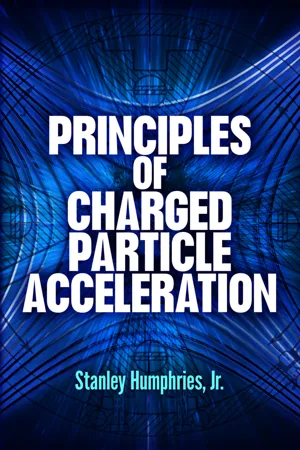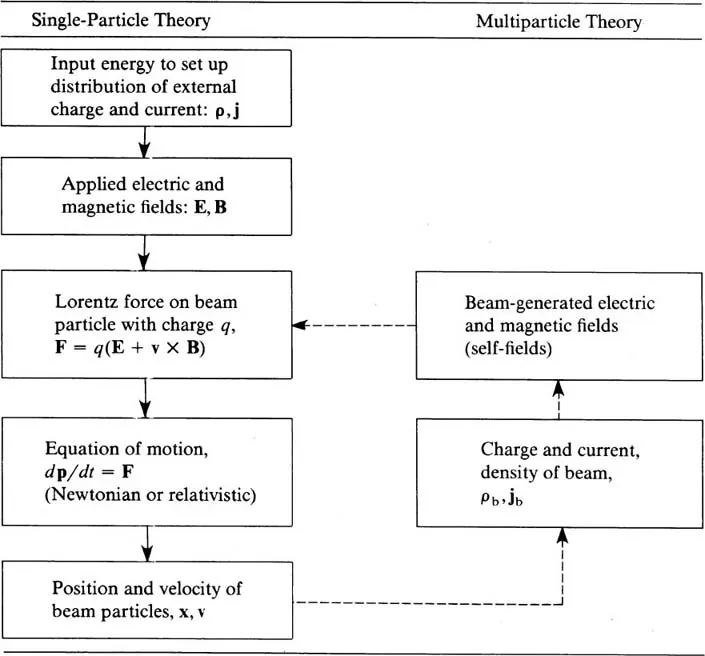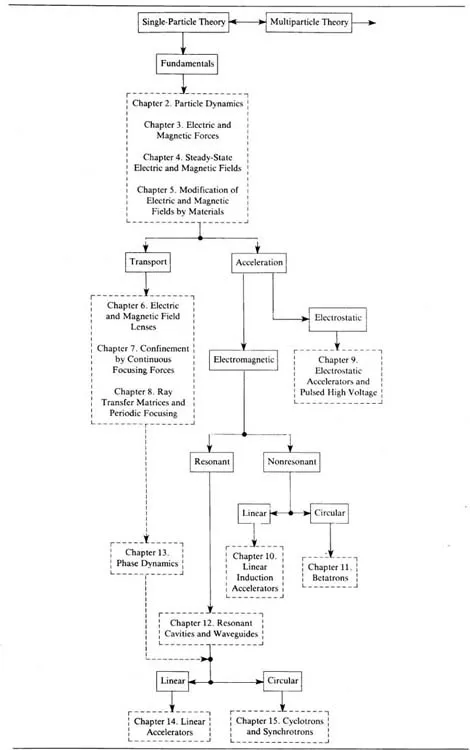![]()
1
Introduction
This book is an introduction to the theory of charged particle acceleration. It has two primary roles:
1.A unified, programmed summary of the principles underlying all charged particle accelerators.
2.A reference collection of equations and material essential to accelerator development and beam applications.
The book contains straightforward expositions of basic principles rather than detailed theories of specialized areas.
Accelerator research is a vast and varied field. There is an amazingly broad range of beam parameters for different applications, and there is a correspondingly diverse set of technologies to achieve the parameters. Beam currents range from nanoamperes (10−9 A) to megaamperes (106 A). Accelerator pulselengths range from less than a nanosecond to steady state. The species of charged particles range from electrons to heavy ions, a mass difference factor approaching 106. The energy of useful charged particle beams ranges from a few electron volts (eV) to almost 1 TeV (1012 eV).
Organizing material from such a broad field is inevitably an imperfect process. Before beginning our study of beam physics, it is useful to review the order of topics and to define clearly the objectives and limitations of the book. The goal is to present the theory of accelerators on a level that facilitates the design of accelerator components and the operation of accelerators for applications. In order to accomplish this effectively, a considerable amount of potentially interesting material must be omitted:
1.Accelerator theory is interpreted as a mature field. There is no attempt to review the history of accelerators.
2.Although an effort has been made to include the most recent developments in accelerator science, there is insufficient space to include a detailed review of past and present literature.
3.Although the theoretical treatments are aimed toward an understanding of real devices, it is not possible to describe in detail specific accelerators and associated technology over the full range of the field.
These deficiencies are compensated by the books and papers tabulated in the bibliography.
We begin with some basic definitions. A charged particle is an elementary particle or a macroparticle which contains an excess of positive or negative charge. Its motion is determined mainly by interaction with electromagnetic forces. Charged particle acceleration is the transfer of kinetic energy to a particle by the application of an electric field. A charged particle beam is a collection of particles distinguished by three characteristics: (1) beam particles have high kinetic energy compared to thermal energies, (2) the particles have a small spread in kinetic energy, and (3) beam particles move approximately in one direction. In most circumstances, a beam has a limited extent in the direction transverse to the average motion. The antithesis of a beam is an assortment of particles in thermodynamic equilibrium.
Most applications of charged particle accelerators depend on the fact that beam particles have high energy and good directionality. Directionality is usually referred to as coherence. Beam coherence determines, among other things, (1) the applied force needed to maintain a certain beam radius, (2) the maximum beam propagation distance, (3) the minimum focal spot size, and (4) the properties of an electromagnetic wave required to trap particles and accelerate them to high energy.
The process for generating charged particle beams is outlined in Table 1.1. Electromagnetic forces result from mutual interactions between charged particles. In accelerator theory, particles are separated into two groups: (1) particles in the beam and (2) charged particles that are distributed on or in surrounding materials. The latter group is called the external charge. Energy is required to set up distributions of external charge; this energy is transferred to the beam particles via electromagnetic forces. For example, a power supply can generate a voltage difference between metal plates by subtracting negative charge from one plate and moving it to the other. A beam particle that moves between the plates is accelerated by attraction to the charge on one plate and repulsion from the charge on the other.
Electromagnetic forces are resolved into electric and magnetic components. Magnetic forces are present only when charges are in relative motion. The ability of a group of external charged particles to exert forces on beam particles is summarized in the applied electric and magnetic fields. Applied forces are usually resolved into those aligned along the average direction of the beam and those that act transversely. The axial forces are acceleration forces; they increase or decrease the beam energy. The transverse forces are confinement forces. They keep the beam contained to a specific cross-sectional area or bend the beam in a desired direction. Magnetic forces are always perpendicular to the velocity of a particle; therefore, magnetic fields cannot affect the particle’s kinetic energy. Magnetic forces are confinement forces. Electric forces can serve both functions.
TABLE 1.1 Acceleration Process
The distribution and motion of external charge determines the fields, and the fields determine the force on a particle via the Lorentz force law, discussed in Chapter 3. The expression for force is included in an appropriate equation of motion to find the position and velocity of particles in the beam as a function of time. A knowledge of representative particle orbits makes it possible to estimate average parameters of the beam, such as radius, direction, energy, and current. It is also possible to sum over the large number of particles in the beam to find charge density ρb and current density jb. These quantities act as source terms for beam-generated electric and magnetic fields.
This procedure is sufficient to describe low-current beams where the contribution to total electric and magnetic fields from the beam is small compared to those of the external charges. This is not the case at high currents. As shown in Table 1.1, calculation of beam parameters is no longer a simple linear procedure. The calculation must be self-consistent. Particle trajectories are determined by the total fields, which include contributions from other beam particles. In turn, the total fields are unknown until the trajectories are calculated. The problem must be solved either by successive iteration or application of the methods of collective physics.
Single-particle processes are covered in this book. Although theoretical treatments for some devices can be quite involved, the general form of all derivations follows the straight-line sequence of Table 1.1. Beam particles are treated as test particles responding to specified fields. A continuation of this book addressing collective phenomena in charged particle beams is in preparation. A wide variety of useful processes for both conventional and high-power pulsed accelerators are described by collective physics, including (1) beam cooling, (2) propagation of beams injected into vacuum, gas, or plasma, (3) neutralization of beams, (4) generation of microwaves, (5) limiting factors for efficiency and flux, (6) high-power electron and ion guns, and (7) collective beam instabilities.
An outline of the topics covered in this book is given in Table 1.2. Single-particle theory can be subdivided into two categories: transport and acceleration. Transport is concerned with beam confinement. The study centers on methods for generating components of electromagnetic force that localize beams in space. For steady-state beams extending a long axial distance, it is sufficient to consider only transverse forces. In contrast, particles in accelerators with time-varying fields must be localized in the axial direction. Force components must be added to the accelerating fields for longitudinal particle confinement (phase stability).
Acceleration of charged particles is conveniently divided into two categories: electrostatic and electromagnetic acceleration. The accelerating field in electrostatic accelerators is the gradient of an electrostatic potential. The peak energy of the beam is limited by the voltage that can be sustained without breakdown. Pulsed power accelerators are included in this category because pulselengths are almost always long enough to guarantee simple electrostatic acceleration.
In order to generate beams with kinetic energy above a few million electron volts, it is necessary to utilize time-varying electromagnetic fields. Although particles in an electromagnetic accelerator experience continual acceleration by an electric field, the field does not require prohibitively large voltages in the laboratory. The accelerator geometry is such that inductively generated electric fields cancel electrostatic fields except at the position of the beam.
TABLE 1.2 Organization of Topics
Electromagnetic accelerators are divided into two subcategories: nonresonant and resonant accelerators. Nonresonant accelerators are pulsed; the motion of particles need not be closely synchronized with the pulse waveform. Nonresonant electromagnetic accelerators are essentially step-up transformers, with the beam acting as a high-voltage secondary. The class is subdivided into linear and circular accelerators. A linear accelerator is a straight-through machine. Generally, injection into the accelerator and transport is not difficult; linear accelerators are useful for initial acceleration of low-energy beams or the generation of high-flux beams. In circular machines, the beam is recirculated many times through the acceleration region during the pulse. Circular accelerators are well suited to the production of beams with high kinetic energy.
TABLE 1.3 Modern Accelerator Applications
Production of short-lived radioisotopies for medical diagnosis Intense ion beams to drive inertial fusion reactors Electron beam... |


